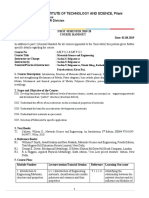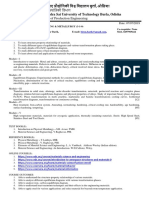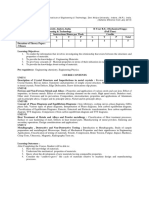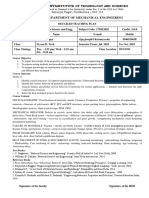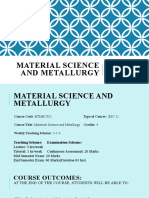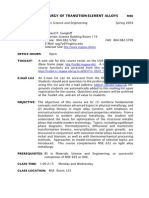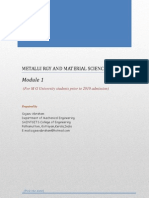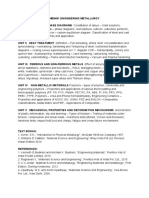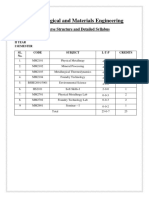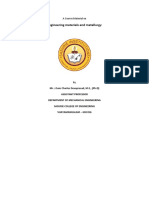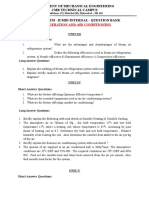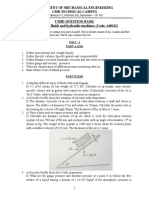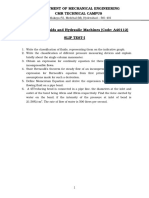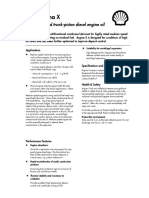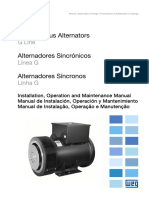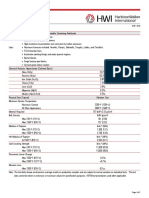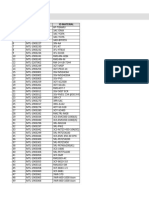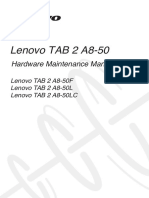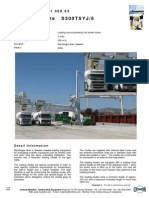CMR TECHNICAL CAMPUS
DEPARTMENT OF MECHANICAL ENGINEERING
Campus: Kandlakoya (V), Medchal Road, Hyderabad-501 401(A.P.)
Title:
Course File on
METALLURGY & MATERIAL SCIENCE
(Code:53018)
Purpose:
The Purpose of this document is to assess (calculate) the course outcomes of this theory course as Outcome Based
Education (OBE).
Scope:
This document describes the objectives & outcomes of the course and organizes Lesson plan, lecture schedule,
Tutorials sheets, Mid internal exam papers, mapping of COs & POs etc in order to evaluate the course outcomes.
Responsible unit:
CMRG - ENGG
Document owner:
Document type:
CMRTC - MECH
Confidentiality status:
Course File
Document state :
Internal
Released
Prepared :
Course Coordinator
Verified :
Module Coordinator
Approved
:
V Shanmukha Prasad
Programme Coordinator
Released :
Dr. A Raji Reddy
Director, CMRTC
Name / Function
Signature
Date
Document Identity Number:
This document and its contents are the property of
CMR Technical campus or its subsidiaries. This
document contains confidential proprietary
information. The reproduction, distribution,
utilization or the communication of this document
or any part thereof, without express authorisation is
C-6.2.1-53018
JNTU Regulations:
Revision :
Original Language :
4.0
EN
�strictly prohibited. Offenders will be held liable for
the payment of damages.
R09
A Y 2013-14
CONTENTS
S No
Description
Page No
Title Page
Course Objectives
Course Syllabus
Text Books/Reference
Lesson Plan
Course Outcomes
Mapping of COs and POs
10
JNTU Academic Calendar
Course Schedule
10
Tutorial Sheets (Problems & Solutions)
11
Assignment Questions
12
Unit-wise Objective Questions
13
MID Exam Question Papers
14
MID Exam Evaluation Reports
15
Previous End Exam Question papers
16
Nominal Rolls
17
Running Notes unit wise
18
Assessment of Cos and POs
19
Attendance Register
20
Result analysis (Bell Curve)
�Appendix-A : Vision, Mission, PEOs & POs
COURSE OBJECTIVES
Metallurgy and Materials Science plays a role in all manufacturing processes
which convert raw materials into useful products adapted to human needs. The primary
focus of the Metallurgy and Materials Science is to provide undergraduates with a
fundamental knowledge-base associated with materials-processing, their properties, and
their selection and application. Upon graduation, students would have acquired and
developed the necessary background and skills for successful careers in the materialsrelated industries.
The central point of this course is to provide a physical basis that links the
structure of materials with their properties, focusing primarily on metals. Furthermore,
after completing the program, the student should be well prepared for management
positions in industry or continued education toward a graduate degree.
On successful completion of this course, the Students will
study the structure of materials and alloys, determination of grain size and grain
boundaries.
gain a fundamental understanding of the concepts of equilibrium diagrams of
different alloys.
know the structure and properties of non-ferrous metals and alloys.
analyze the proper selection of material for any specific application
get knowledge about mechanical and thermal treatment applicable to different
materials.
know the classification of composites and their applications.
Prerequisites (Flow chart):
Course
Metallurgy & Material
Science
I B Tech
Engineering Physics
Engineering Chemistry
Mathematics
Engineering Workshops
�Course Plan
S. No
Plan
Brief Description
a.
Class Lectures
64 Lectures as per the JNTU Regulations
b.
Design Issues
Nil
c.
Presentations
Presentation on equilibrium diagrams
d.
Demonstration
Drawing Phase diagram using Videos
e.
Models / Mini Projects
-Nil
f.
Beyond Curriculum
Elevated temperature behavior of metals
Method of Evaluation
Objective Type - 10Marks
a
2 MID term Examinations (Average)
Descriptive Type - 10 Marks
25%
Assignments - 05 Marks
b
End Semester Examination (JNTU)
Descriptive Type 75 Marks
75%
Student Guidelines
Course topics will be covered by both lectures and tutorials. The main purposes of the
tutorials are:
1) Provide additional discussion and equilibrium diagram of Fe-Fe3C compatible with the
lecture materials, and
2) Have a more informal opportunity to explore issues and ask questions about lectures,
texts and previously assigned materials which require clarification.
Lecture and laboratory attendance is important for maximizing the learning
benefits of this course and therefore regular attendance is expected. Learning is motivated
through active discussion, demonstration and practice of the topics being studied.
Two assignment tests and two mid-term exams will be given during the semester
and a final exam will be given during exam week. All exams will be closed-book, closednotes. The assignment test (any two questions from six questions) will be in-class during
the regular lecture time. The Mid terms and final exam will be given according to the
JNTU schedule.
�Resources
The assignment questions and question bank will be published on college website i. e
www.cmrtc.ac.in/Forums. All students will have an account on Forums and are expected to check
this site frequently for any material and announcements. It is also imperative that students ensure
that their current e-mail address is registered.
�JNTU S YLLAUS
L
4
T/P/D
1/-/-
C
4
UNIT-I: STRUCTURE OF METALS
Bonds in Solids Metallic bond crystallization of metals, grain and boundaries, effect
of grain boundaries on the properties of metal / alloys determination of grain size
UNIT-II: CONSTITUTION OF ALOYS
Necessity of alloying, types of solid solutions, Hume Rotherys rules, intermediate alloy
phases, and electron compounds.
UNIT-III: EQUILIBRIUM OF DIAGRAMS
Experimental methods of construction of equilibrium diagrams, Isomorphous alloy
systems, equilibrium cooling and heating of alloys, Lever rule, coring miscibility gaps,
eutectic systems, congruent melting intermediate phases, peritectic reaction.
Transformations in the solid state allotropy, eutectoid, peritectoid reactions, phase rule,
relationship between equilibrium diagrams and properties of alloys. Study of important
binary phase diagrams of Cu-Ni-, Al-CU, Bi-Cd, Cu-An, Cus-Sn and Fe-Fe3C.
UNIT-IV: CAST IRONS AND STELLS
Structure and Properties of White Cast iron, Malleable Cast iron, grey cast iron, Spherical
graphite cast iron, Alloy cast iron. Classification of steels, structure and properties of
plain carbon steels, Low alloy steels, Hadfield manganese steels, tool and die steels.
UNIT-V: HEAT TREATMENT OF ALLOYS
Effect of alloying elements on Fe-Fe 3C system, Annealing, normalizing, Hardening, TTT
diagrams, tempering, Harden ability, surface hardening methods, Age hardening
treatment, Cryogenic treatment of alloys.
UNIT-VI: NONFERROUS METALS AND ALLOYS
Structure and properties of copper and its alloys, Aluminum and its alloys, Titanium and
its alloys.
UNIT-VII: CERAMIC MATERIALS
Crystalline ceramics, glasses, ceramics, abrasive materials, nanomaterials definition,
properties and applications of the above.
UNIT-VIII: COMPOSITE MATERIALS
Classification of composites, various methods component manufacture of composites,
particle reinforced materials, fiber reinforced materials, metal ceramic mixtures, metal
matrix composites and C C composites.
�BOOKS / MATERIAL
Text Books
1
Introduction to Physical Metallurgy/Sidney H. Avner
Material science & Metallurgy / Kodgire
Suggested / Reference Books
3
Metallurgy and Material Science by Pakirappa / Durga Publishing House
Elements of Material Science and Engineering / Van Vlack
Science of Engineering Materials / Agarwal
Materials Science / Singh
Elements of Material Science / V.Raghavan
Materials Science by R.S. Khurmi / R.S. Sedh / .Schand Publishers
Mechanical Metallurgy by Dieter
Web Sites
a
College Data Share http://172.16.1.220/ for Tutorials & Video lectures
www.cmrtc.ac.in/Forums for Student hand book for Assignment problems
www.mitopencourse.com
www.google.com/scholar
LESSON PLAN
�Period
Chapter/Topic in
Text/Reference Book
I
II
Topic
Unit I
Introduction to the subject
Introduction to the structure of metals
Bonds in solids and their types
Metallic bond Unit cell & Bravais Lattices
Crystallization of metals with their grain size and grin
boundaries.
Effect of grain boundaries Properties of metal and alloys
Determination of grain size
B-1; Pg-65
2.1, 2.2
B-1; Pg-78
2.11- 2.15
B-1; Pg-76
2.7 - 2.10
B-1; Pg- 80
2.13 - 2.15
B-1;Pg-100
2.23 & 2.24
B-1; Pg-94
2.21
B-1;Pg-100
2.24
R-3 Pg-7
1.1 & 1.2
R-3 Pg-23
1.8-1.8.4
R-3 Pg-14
1.3-1.3.6
R-3 Pg-20
1.7
R-3 Pg-50
1.17
R-3 Pg-52
1.17
R-3 Pg-50
1.17
B-1;Pg -147
5.1, 5.2
B-1;Pg -148
5.3, 5.4
B-1;Pg -150
5.5 - 5.7
B-1; Pg 150
5.4
B-1;Pg -148
5.4
B-1;Pg -150
5.4
R-3 Pg-65
2.1 & 2.2
R-3 Pg-66
2.2
R-3 Pg-67
2.3.1
R-3 Pg-67
2.3.1
R-3 Pg-68
2.4
R-3 Pg-69
2.4
B-1;Pg -156
6.1, 6.2
B-1; Pg-156
6.3 & 6.4
B-1; Pg-159
6.5 & 6.6
B-1; Pg-161
6.7 & 6.9
R-3 Pg-73
3.1
R-3 Pg-75
3.4
R-3 Pg-79
3.7.1
R-3 Pg-74
3.3
R-3 Pg-76
3.4
R-3 Pg-81
3.7.2
Unit II
Introduction to alloys
Necessity of alloying elements
10
Types of solid solutions
11
Hume Rotherys rule
12
Intermediate alloy phases
13
Electron compound
Unit III
14
Introduction to equilibrium diagrams
15
Construction of equilibrium diagrams
16
Isomorphous alloy system
17
Equilibrium cooling and heating of alloys
18
Lever rule, coring miscibility gaps
19
Eutectic system intermediate phases & peritectic
-B-1; Pg-171
6.13
�Period
Topic
Chapter/Topic in
Text/Reference Book
I
II
--B-1; Pg-195 R-3 Pg-81
6.17
B-1; Pg-212
-6.24 & 6.25
20
Transformation in solid state allotropy
21
Intermediate phases
22
Eutectoid and peritectoid reactions
23
Phase rule, relation between equilibrium diagram &
properties
--
24
Binary phase diagram of Cu-Ni, Cu-An
--
25
Phase diagram of Bi-Cd, Cus-Sn, Fe-Fe3C
--
-R-3 Pg-80
Fig-3.7
R-3 Pg-84
Fig-3.12
Unit IV
B-1;Pg-423
11.1
26
Cast Iron & Steels Introduction
27
Structure and properties of white cast iron
28
Types & properties of white cast iron
29
Types and properties of Malleable cast iron
30
Types and properties of grey cast iron
31
Types and properties of Spheriodal graphit cast iron
32
Types and properties of Alloy cast iron
33
Classification of steels
34
Structure & properties of plain carbon steels
--
35
Structure & properties of Low alloy steels
--
36
Handfield manganese steels, tool & die steels
--
-B-1;Pg-424
11.3
B-1;Pg-426
11.4
B-1;Pg-434
11.6
B-1;Pg-450
11.15
B-1;Pg-453
11.16
B-1;Pg-349
9.1 & 9.2
R-3 Pg-143
6.1
R-3 Pg-145
6.2.1
R-3 Pg-145
6.2.1
R-3 Pg-148
6.2.4
R-3 Pg-146
6.2.2
R-3 Pg-147
6.2.3
R-3 Pg-149
6.2.5
R-3 Pg-119
5.1
R-3 Pg-120
5.2
R-3 Pg-123
5.4
R-3 Pg-127
5.4.5
Unit V
37
Heat treatment of alloys
38
Effect on Fe-Fe3C system
39
Annealing and their types
-B-2;Pg 308
9.2
B-2;Pg 373
9.21 - 9.26
R-3 Pg-157
7.1
R-3 Pg-104
4.6
R-3 Pg-165
7.8
�Period
Topic
40
Normalizing, Hardening
41
TTT diagrams different types
42
Tempering and types
43
Hardening and its types
44
Surface hardening & Age hardening methods
45
Cryogenic treatment of alloys
Chapter/Topic in
Text/Reference Book
I
II
B-2;Pg 377 R-3 Pg-169
9.27 & 9.28
7.9
B-2;Pg 348 R-3 Pg-159
9.13
7.4
B-2;Pg 386 R-3 Pg-172
9.32
7.11
B-2;Pg 378 R-3 Pg-171
9.28
7.10
R-3 Pg-178
B-2; Pg 517
7.16&Pg& 400 13.5
181, 7.17
R-3 Pg-184
-7.19
Unit VI
46
Non- ferrous metals and alloys
47
Structure & properties of copper and its alloys
48
Structure & properties of Aluminium and its alloys
49
Structure & properties of titanium and its alloys
B-1;Pg-461
12.1
B-1;Pg-461
12.2 - 12.15
B-1;Pg-481
12.16 - 12.2
B-1;Pg-524
12.38,
12.39
R-3 Pg-193
8.1
R-3 Pg-194
8.2
R-3 Pg-197
8.3
R-3 Pg-199
8.4
Unit VII
50
Ceramic materials and Crystalline ceramics
--
51
Glasses and their types
--
52
Cermaets & Abrasive materials
--
53
Nano materials and their applications and types
--
54
Properties and applications
--
R-3 Pg-223
10.1
R-3 Pg-231
10.7-10.7.2
R-3 Pg-235
10.9
R-3 Pg-240
10.12
R-3 Pg-240
10.12
Unit VIII
55
Composite materials
56
Classification of composites
57
Various manufacture composites
58
Particle reinforced materials and Fiber reinforced
materials
B-2;Pg 522
13.7
B-2;Pg 522
13.7
-B-2;Pg 522
13.7
R-3 Pg-247
11.1
R-3 Pg-247
11.2
R-3 Pg-247
11.2
R-3 Pg-27
11.2.1
�Period
Topic
59
Metal matrix composition, Metal matrix composition
60
C-C composites
COURSE OUTCOMES
Chapter/Topic in
Text/Reference Book
I
II
R-3 Pg-253
-11.3.1
R-3 Pg-25
-11.3.3
�After successful completion of this course, the students should be able to
CO1:
- understand the relationship between crystal structure and microstructure of materials
and mechanical properties.
[UNIT-I & IV]
CO2:
-
identify, analyze and interpret the phases and microstructure of common ferrous and
non-ferrous materials.
[UNIT II, III & VI]
CO3:
-
understand and identify suitable heat treatment process for common engineering
applications for ferrous and non-ferrous materials.
[UNIT V]
CO4:
-
understand structure, properties and processing methods for ceramic materials and
composite materials.
[UNIT VII & VIII]
MAPPING OF COs to POs
�PO
No
10
11
PO DESCRIPTION
An ability to apply knowledge of mathematics,
science, engineering fundamentals and an
engineering specialization for the solution of
complex engineering problems in Mechanical
engineering.
An ability to identify, formulate, research
literature, analyze complex engineering problems
in mechanical engineering using first principles of
mathematics, natural sciences and engineering
sciences.
An ability to design solutions for complex
engineering problems and system component or
processes that meet the specified needs
considering public health & safety and cultural,
societal & environment.
An ability to use research-based knowledge and
research
methods
including
design
of
experiments, analysis and interpretation of data
and synthesis of the information to obtain
solutions to Mechanical engineering problems.
Ability to create, select and apply appropriate
techniques, resources and modern engineering
activities, with an understanding of the limitations.
Ability to apply reasoning informed by the
contextual knowledge to assess societal, health,
safety, legal and cultural issues and the consequent
responsibilities relevant to the professional
engineering practice.
Ability to demonstrate the knowledge of
engineering solutions, contemporary issues
understanding their impacts on societal and
environmental
contexts,
leading
towards
sustainable development.
An ability to apply ethical principles and commit
to professional ethics and responsibilities and
norms of engineering practice.
An ability to function effectively as an individual,
and as a member or leader in diverse teams and in
multi-disciplinary settings.
Ability to communicate effectively oral, written
reports and graphical forms on complex
engineering activities.
Ability
to
demonstrate
knowledge
and
understanding of the engineering and
Mapping of Cos with POs
CO1
CO2
CO3
CO4
�PO
No
12
PO DESCRIPTION
Mapping of Cos with POs
CO1
CO2
CO3
CO4
management principles and apply those ones own
work, as a member and leader in team, to manage
projects and in multi-disciplinary environments.
An ability to recognize the need for and having
the preparation and ability to engage independent
and life-long learning in broadest context of
technological change.
COURSE SCHEDULE
Number of Hours / lectures available in this Semester / Year
80
�Distribution of Hours Unit Wise
Unit
Date
Topic
From
To
Total No. of
Hours
Structure of Metals
07
II
Necessity of Alloying elements
06
III
Equilibrium Diagrams
12
IV
Cast Irons
11
Heat Treatment of Alloys
09
VI
Non-ferrous metals
04
VII
Ceramic Materials
05
VIII
Composite Materials
06
Contact classes for syllabus coverage
60
Lectures beyond syllabus
02
Tutorial classes
16
Remedial classes
02
Total No. of classes
80
�CMR TECHNICAL CAMPUS
DEPARTMENT OF MECHANICAL ENGINEERING
Campus: Kandlakoya (V), Medchal Road, Hyderabad-501 401(A.P.)
Title:
Course File on
METALLURGY & MATERIAL SCIENCE
(Code:53018)
Purpose:
The Purpose of this document is to assess (calculate) the course outcomes of this theory course as Outcome Based
Education (OBE).
Scope:
This document describes the objectives & outcomes of the course and organizes Lesson plan, lecture schedule,
Tutorials sheets, Mid internal exam papers, mapping of COs & POs etc in order to evaluate the course outcomes.
Responsible unit:
CMRG - ENGG
Document owner:
Document type:
CMRTC - MECH
Confidentiality status:
Course File
Document state :
Internal
Released
Prepared :
Asst professor, CMRTC-MECH
Verified :
Asst. Prof., CMRTC-MECH
Approved
:
V Shanmukha Prasad
Professor, CMRTC
Released :
Dr. A Raji Reddy
Director, CMRTC
Name / Function
Signature
Date
Document Identity Number:
This document and its contents are the property of
CMR Technical campus or its subsidiaries. This
document contains confidential proprietary
information. The reproduction, distribution,
utilization or the communication of this document
or any part thereof, without express authorisation is
C-6.2.1-53018
JNTU Regulations:
Revision :
Original Language :
3.0
EN
�strictly prohibited. Offenders will be held liable for
the payment of damages.
A Y 2012-13
R09
COURSE SCHEDULE
Number of Hours / lectures available in this Semester / Year
80
Distribution of Hours Unit Wise
Unit
Date
Topic
From
To
Total No. of
Hours
Structure of Metals
07
II
Necessity of Alloying elements
06
III
Equilibrium Diagrams
12
IV
Cast Irons
11
Heat Treatment of Alloys
09
VI
Non-ferrous metals
04
VII
Ceramic Materials
05
VIII
Composite Materials
06
Contact classes for syllabus coverage
60
Lectures beyond syllabus
02
Tutorial classes
16
Remedial classes
02
Total No. of classes
80
�CMR TECHNICAL CAMPUS
DEPARTMENT OF MECHANICAL ENGINEERING
Campus: Kandlakoya (V), Medchal Road, Hyderabad-501 401(A.P.)
Title:
Course File on
METALLURGY & MATERIAL SCIENCE
(Code:53018)
Purpose:
The Purpose of this document is to assess (calculate) the course outcomes of this theory course as Outcome Based
Education (OBE).
Scope:
This document describes the objectives & outcomes of the course and organizes Lesson plan, lecture schedule,
Tutorials sheets, Mid internal exam papers, mapping of COs & POs etc in order to evaluate the course outcomes.
Responsible unit:
CMRG - ENGG
Document owner:
Document type:
CMRTC - MECH
Confidentiality status:
Course File
Document state :
Internal
Released
Prepared :
Asst professor, CMRTC-MECH
Verified :
Asst. Prof., CMRTC-MECH
Approved
:
V Shanmukha Prasad
Professor, CMRTC
Released :
Dr. A Raji Reddy
Director, CMRTC
Name / Function
Signature
Date
Document Identity Number:
This document and its contents are the property of
CMR Technical campus or its subsidiaries. This
document contains confidential proprietary
information. The reproduction, distribution,
utilization or the communication of this document
or any part thereof, without express authorisation is
C-6.2.1-53018
JNTU Regulations:
Revision :
Original Language :
2.0
EN
�strictly prohibited. Offenders will be held liable for
the payment of damages.
A Y 2011-12
R09
COURSE SCHEDULE
Number of Hours / lectures available in this Semester / Year
80
Distribution of Hours Unit Wise
Unit
Date
Topic
From
To
Total No. of
Hours
Structure of Metals
07
II
Necessity of Alloying elements
06
III
Equilibrium Diagrams
12
IV
Cast Irons
11
Heat Treatment of Alloys
09
VI
Non-ferrous metals
04
VII
Ceramic Materials
05
VIII
Composite Materials
06
Contact classes for syllabus coverage
60
Lectures beyond syllabus
02
Tutorial classes
16
Remedial classes
02
Total No. of classes
80
�CMR TECHNICAL CAMPUS
DEPARTMENT OF MECHANICAL ENGINEERING
Campus: Kandlakoya (V), Medchal Road, Hyderabad-501 401(A.P.)
Title:
Course File on
METALLURGY & MATERIAL SCIENCE
(Code:53018)
Purpose:
The Purpose of this document is to assess (calculate) the course outcomes of this theory course as Outcome Based
Education (OBE).
Scope:
This document describes the objectives & outcomes of the course and organizes Lesson plan, lecture schedule,
Tutorials sheets, Mid internal exam papers, mapping of COs & POs etc in order to evaluate the course outcomes.
Responsible unit:
CMRG - ENGG
Document owner:
Document type:
CMRTC - MECH
Confidentiality status:
Course File
Document state :
Internal
Released
Prepared :
Asst professor, CMRTC-MECH
Verified :
Asst. Prof., CMRTC-MECH
Approved
:
V Shanmukha Prasad
Professor, CMRTC
Released :
Dr. A Raji Reddy
Director, CMRTC
Name / Function
This document and its contents are the property of
CMR Technical campus or its subsidiaries. This
document contains confidential proprietary
information. The reproduction, distribution,
utilization or the communication of this document
Signature
Date
Document Identity Number:
C-6.2.1-53018
JNTU Regulations:
Revision :
Original Language :
�or any part thereof, without express authorisation is
strictly prohibited. Offenders will be held liable for
the payment of damages.
1.0
R09
EN
A Y 2010-11
COURSE SCHEDULE
Number of Hours / lectures available in this Semester / Year
80
Distribution of Hours Unit Wise
Unit
Date
Topic
From
To
Total No. of
Hours
Structure of Metals
07
II
Necessity of Alloying elements
06
III
Equilibrium Diagrams
12
IV
Cast Irons
11
Heat Treatment of Alloys
09
VI
Non-ferrous metals
04
VII
Ceramic Materials
05
VIII
Composite Materials
06
Contact classes for syllabus coverage
60
Lectures beyond syllabus
02
Tutorial classes
16
Remedial classes
02
Total No. of classes
80




















